#slender mongoose
Text
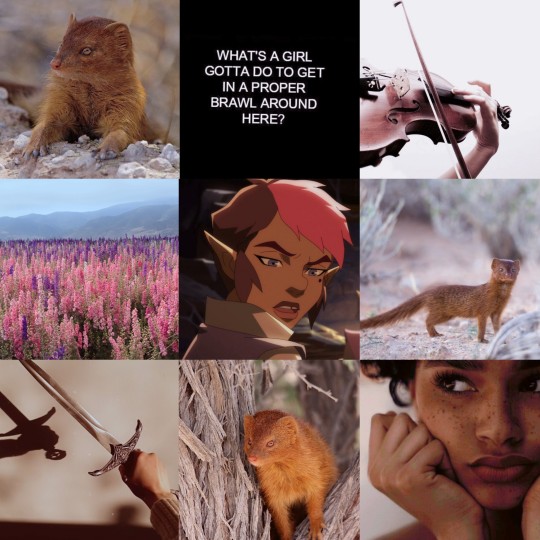
Vox Machina
Kaylie Shorthalt & Harper
#critical role#kaylie shorthalt#vox machina#daemon au#daemons machina#daemons#daemon#slender mongoose
16 notes
·
View notes
Text

Common slender mongoose (Herpestes sanguineus)
Kruger National Park, South Africa
Photo © bjptada
49 notes
·
View notes
Text
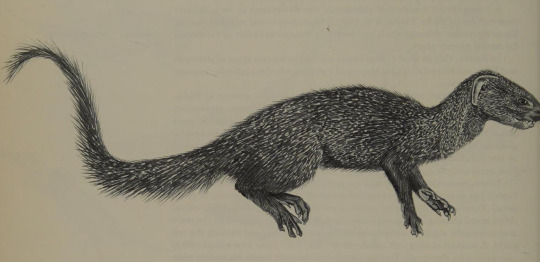


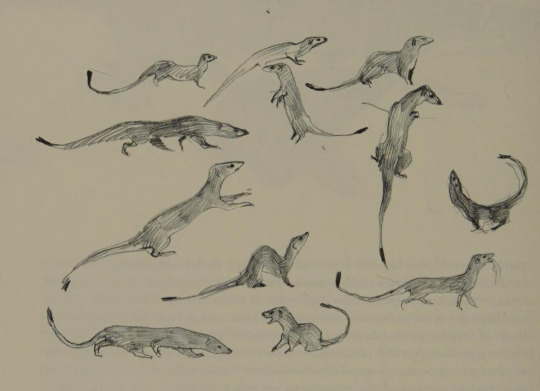
Slender Mongooses from East African Mammals vol. IIIA. Written/illustrated by Jonathan Kingdon. 1971.
177 notes
·
View notes
Text
One Piece x Daemon AU
Straw Hat Pirates' Daemons

Luffy - Peregrine Falcon (separated by DF): Settling abnormally young—at only 7 years old when Shanks gave him his hat—Luffy’s daemon is associated with freedom, intuition, and bravery. The fastest bird in the world, these falcons are also associated with a number of gods, including the sun god Ra and the sky god Horus, and are sometimes considered king of the birds. Luffy’s daemon shape was heavily influenced by his Devil Fruit and the strength of his personal goals/dreams, since his own personality is already very open, honest, and straightforward (thus, he already bares his soul to the world, even without a daemon). The small size of his daemon also often leads others to underestimate him.
Zoro - Wolf-Dog: Is anyone surprised? Zoro’s daemon reveals his nature as a mix of wild animal and loyal pet. While dog daemons are associated with servitude, wolf daemons are neither docile nor friendly (to most strangers, at least). I found this mix of loyalty, wildness, ferocity, and an orientation towards pack/protection to be a good fit for Zoro. (Especially cause everyone calls him Luffy’s loyal attack dog anyway😛). (During the time skip, Zoro separated with his daemon under Mihawk’s instruction.)
Nami - Red Fox: Foxes have it all—associated with tricksters and hoarders, cuteness and sexiness, aggression and playfulness, Nami’s daemon works well with here, both when they’re trying to survive under Arlong and as Luffy’s navigator. While sometimes associated with thieves, foxes are also known as spirits who help those in need (and punish those who are arrogant). The fox is also sometimes depicted as a guide between worlds, perfect for a navigator.
Usopp - Great Horned Owl: Usopp is the only crew member whose daemon isn’t settled before joining. His daemon settles after Ennie’s Lobby, but prior to that, she often took the form of a cape hare. Associated with wisdom, intuition, self-actualization, and victory in battle, I chose an owl for Usopp in part b/c I wanted to relate and contrast him with Luffy (both birds of prey). I also chose an owl b/c of they’re “silent killers”—appropriate for a sniper! (During the time skip, Usopp would train to separate with his daemon, but ultimately only stretched their bond, unable to fully separate.)
Sanji - Slender Mongoose: This daemon is associated with boldness, rebellion, and resourcefulness, and they’re known for taking on predators that are much bigger and badder than them (look up the mongoose vs lion confrontation!). Mongoose are also considered a protector of gods, and can be very cooperative and family-oriented. I chose a mongoose in-part because of their unassuming, rodent-like appearance (and also for the mental image of Sanji cooking with his cute mongoose daemon hanging around his neck).
Chopper - Anna's Hummingbird (separated by DF): One of the only hummingbird species that sticks around during winter, this daemon is associated with luck, healing, life, and tenacity. Chopper’s daemon appeared after he ate his Devil Fruit (and gained a human soul), and settled after Hiriluk’s death. In part, I chose this hummingbird for its pink head and b/c it’d be really cute perched on Chopper’s antler.
Robin - Spotted Hyena (separated by DF): While they’re associated with evil, impurity, and stupidity, the hyena is actually an intelligent, nurturing, and courageous animal. Settling young, only a short year after her escape from Ohara, Robin’s daemon is a reflection of both who she is and who people believe her to be. Her daemon’s form was also taken for protection—for much of her life, Robin needed a daemon who could fight back when their backs were to a wall. Luckily, once she joins the Straw Hats, she and her daemon finally find the family group they’ve been looking for, where their kindness can flourish.
Franky - Painted Dog: Franky is by no means the type to have a domesticated dog daemon, but as someone who is family-oriented, friendly, and playful (and tough as hell), a wild painted dog is a good fit. After being hit by the sea train, Franky’s daemon ended up heavily scarred, giving her a fierce look.
Brook - White Satin Moth (separated by DF): With delicate, all-white wings, these moths are often seen as symbols of loved ones visiting from the afterlife. Prior to their death, though, Brook’s daemon was a mourning dove, chosen both for the symbolism of death/mourning and because they have my favorite bird call. Imagine the duets when they were alive…

Bonus (under Read more): Ace, Sabo, Shanks, & Law! Plus, some world-building thoughts:

Ace - Lion (separated by DF): While a large, threatening predator, lions are also one of the few big cats that typically live in family groups. Ace’s daemon took this form both as a form of defense, as well as misdirection—they deeply crave family, connection, and acceptance, but can be held back by their own anger and distrust. Lions are associated with royalty, but are not associated with pirates the way bird daemons are.
Sabo - Caracal: Associated with being protectors of gods, I mostly chose a caracal for their unique jumping (reminded me of Sabo’s fighting style) and the cute ears. Both he and Ace have individualistic/loner personalities that lend them towards cat daemons, but unlike Ace, Sabo is less concerned with a family connection. Caracals are associated with both hunting and protection. (Also, I can definitely see Sabo’s daemon playing with Luffy’s by jumping to catch them^^)
Shanks - Raven (separated): One of the smartest birds around, ravens are often known as harbingers of death and doom. They are also known to communicate with other ravens about who friends and foes are, and will be friendly or hostile accordingly. Shanks and his daemon separated the traditional way, by purposeful stretching of the bond until it broke.
Law - Black-footed Cat (separated by DF): I know, I know, everyone gives him a snow leopard, which I respect, but!! This cat is the deadliest wild cat in the world with the highest kill count. Deceptively small and cute, they are known for their tenacity, bravery, and ferocity. For Law, I wanted to highlight his upbringing as the child of 2 doctors & his connection to Cora—he had a normal childhood, before everything fell apart, but his experiences surviving in Flevance and with Cora led him to a smaller, quieter daemon that wouldn’t draw attention. Also, while fierce and dangerous, Law can still be quite cute, imo🥰. And with such a small/non-threatening looking daemon, Law would tend towards hiding them, making himself appear more threatening (as people are naturally off-put by a lack of daemon).
World-building:
When a person eats a Devil Fruit, the power also applies to their daemon. (Ex: When Bon Clay mimics someone's face, his daemon can also mimic their daemon.)
When a person eats a Devil Fruit, they and their daemon are separated. Unlike the traditional and artificial methods of stretching and separating from one’s daemon, Devil Fruit separation is largely painless.
Daemons can use haki, but it is very difficult, requiring training.
It's highly stigmatized in most of the world for daemons of strangers to touch, including in fights. Pirates' daemons, however, are often seen fighting each other. However, even among pirates, it's taboo to touch another's daemon without permission.
Bird daemons are stigmatized due to their association with piracy during the pirate era (Gol Roger's daemon was a golden eagle). (Each of the Straw Hats who have/had bird daemons do so because their dreams involve being a pirate specifically.)
All races in OP have externalized souls (ex: Minks have visible auras that can interact with each other. Fishmen/merpeople have sentient water—think Moana—that follows them or is kept in special jewelry.)
#one piece#daemon au#monkey d. luffy#roronoa zoro#usopp#one piece usopp#nami#cat burglar nami#one piece nami#tony tony chopper#one piece chopper#nico robin#franky#one piece franky#soul king brook#one piece brook#portgas d ace#sabo#revolutionary sabo#shanks#red hair shanks#one piece shanks#trafalgar law#one piece law#op x daemon au#sanji#black leg sanji
48 notes
·
View notes
Video
youtube
Chester Zoo FIRST: Rare Fossa Triplets Born
The 12-week-old pups, who have arrived to parents Shala and Isalo are only now beginning to venture outside after remaining tucked away for their first few weeks of life.
The trio are a “huge cause for celebration” as they are the first of their kind to ever be born at the zoo in its 91-year history.
Conservationists have released heart-warming footage of the delightful pups exploring and playing together in their habitat, and say they will soon be choosing names for the trio which have been revealed as a male and two females.
A distant relative of the mongoose, the fossa is a slender, cat-like mammal that’s only found in the forests of Madagascar. The rare carnivore is equipped with a long tail that helps it balance when leaping amongst the tree branches, as well as large eyes that help it to see better at night when hunting for prey such as lemurs, wild pigs and mice.
The fossa is highly threatened as a result of widespread habitat loss in Madagascar. Scientists report that the island has already lost up to 90% of its forests, which means that many species are now on the very brink of extinction...
Read more: Chester Zoo - YouTube
325 notes
·
View notes
Text
🐾 Daily Animal 🐾
The animal of the day is...
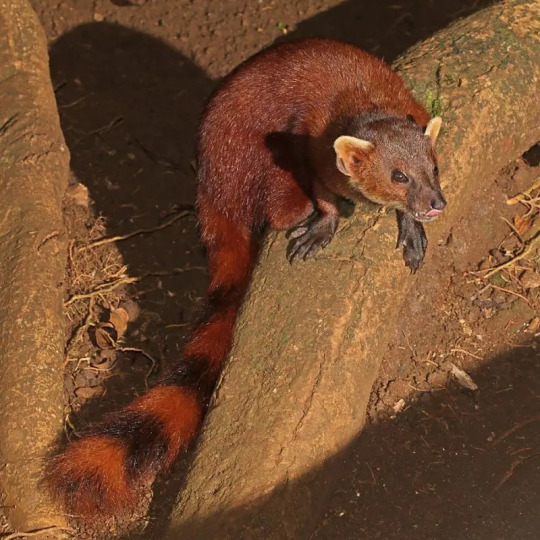
Ring Tailed Vontsira/ Ring Tailed Mongoose!
The ring tailed mongoose is a part of the eupleridae family, and galidia genus, with their specific species being known as the Galidia elegans- which fits them quite well as it translates to 'elegant young weasel'.
They have long slender bodies, with a rounded head and pointed snout. Their fur is dark red, they have black feet, and their tails have black and red bands similar to the red panda- and also give them their name.
These mongoose are found in Madagascar, living in both humid montane forest, and dry deciduous forest to the west.
They are diurnal, meaning they sleep at night, typically in tree cavities or burrows that they dig themselves.
They are very agile, good climbers and adapt swimmers. They can be quite playful, and social- usually they're found in pairs with up to three offspring.
Scent marking is a very important part of their communication.
Ring tailed mongoose are carnivores, with their diets consisting mainly of small mammals, invertebrates, fish, reptiles, and eggs- though they will occasionally eat insects and fruit.
Their population in the wild is unknown, however it is known that their number is decreasing due to habitat loss, hunting, and competition with other animals such as civets, dogs and cats.
However they are considered Least Concern on the IUCN Red List.
#animals#animal#animal info#ring tailed mongoose#ring tailed vontsira#animal facts#wildlife#wild animals#mammals#galidia elegans#max-talks-animals
8 notes
·
View notes
Text
Uncharismatic Fact of the Day
For some animals, a snake’s hiss is worse than its bite. Mongooses, honey badgers, hedgehogs, and pigs are all immune to snake venom. All these species have independently evolved this trait, which is a result of a mutation which prevents snake venom α-neurotoxin from binding to their cell receptors.

Image: A common slender mongoose (H. sanguineus) by Matthew Thayer
#mongoose#honey badger#hedhehogs#badgers#pigeons#carnivora#Herpestidae#carnivores#Mustelidae#mustelids#Eulipotyphla#Erinaceidae#Artiodactyla#suidae#even-toed ungulates#ungulates#mammals#uncharismatic facts
118 notes
·
View notes
Text
Anthro Allies Remastered (Part 5)




Part Three Of Mammals
Eulipotyphia
Vaughan (Solenodon)
Piniqua (Hedgehog)
Gymmy (Moonrat)
Enki (Mole)
Rapid (Shrew)
Dazzle (Desman)
Chiroptera
Wisteria (Pallid Bat)
Maurice (Golden Crowned Flying Fox)
Pholidota
Layers (Giant Pangolin)
Towana (Tree Pangolin)
Carnivora
Caniformes
Havak (Dire Wolf)
Zerdaunki (Fox/Tanuki)
Mapuche (Maned Wolf/Short Eared Dog)
Debby (Small Dog Hybrid)
Farrah (Bear)
Kiala (Spectacled Bear/Panda)
Quigley (Fur Seal/Sea Lion)
Poppy (Seal Hybrid)
Brian (Walrus)
Ursula (Elephant Seal)
Rogue (Red Panda)
Zixi (Skunks)
Dacoit (Procyon Hybrid)
Chiraz (Grison)
Yeast (Weasel)
Vega (Ferret/Mink/Ermine)
Everett (Guloninae hybrid)
Ratel (Honey badger)
Warren (badger)
Stream (Otter)
Feliforms
Zimiri (Lyoki Cat/Panther)
Kenzo (Tiger/Lion)
Rhonda (Lynx/Maine coon)
Guy (Black Footed Cat)
Lynn (Asiatic Linsang)
Musang (African Palm Civet)
Feral (Spotted Hyena)
Zag (Striped Hyena)
Zig (Brown Hyena)
Mounda (Aardwolf)
Sleek (Slender Mongoose)
Nimble (Yellow Mongoose)
Trixie (Meerkat)
Chaz (Kusimanse)
Cosima (Fossa)
Erik (Ring Tailed Vontsira)
Dvita (Falanouc)
Alan (Oyan)
Percy Civet/Genet)
Kernal (Binturong)
Previous/Next
(For More Information About The Earthdemons, Neo demons, The Anthro allies , the O'Kong family and more of theses characters as well as updates please visit the @the-earthdemon-hub for more)
#my art#my ocs#elementalgod aj#aj the elementalgod#isle 0#Toonverse oc#The Watchful Eye#Watchful Eye#O'Kong Family#Earthdemon#Neo Demons#Anthro Allies#mammals
6 notes
·
View notes
Note
Figuring out my daemon is likely a mongoose, combined with the fact of finding out that these little dudes (Namibian black slender mongooses) exist has been cool as heck and I wanted to say think you, so here are some Hella cute pictures of Namibian black mongooses💛

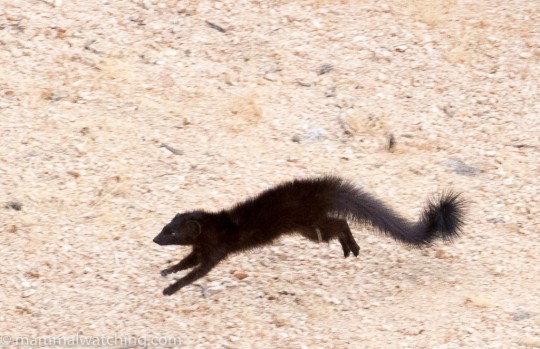
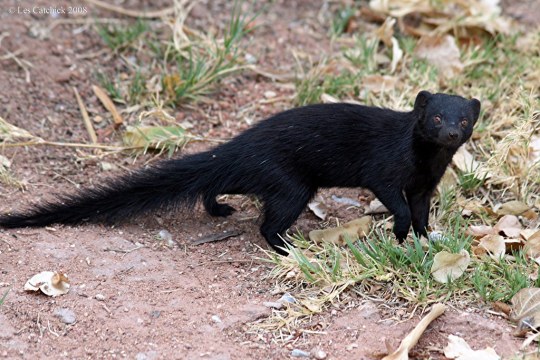
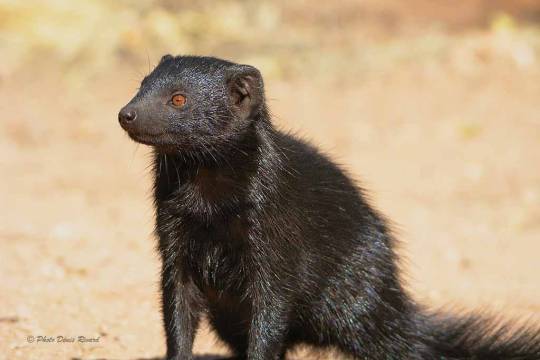
oh my gosh what an AMAZING little guy!! that second picture has me cracking up, look at him go! what a fantastic daemon, i love hearing about what form people have settled on! :)
#personal#please send me stuff about your daemon form any time#esp if you've previously sent me a request!!#daemonism
24 notes
·
View notes
Text
Character stats framework
Repost, don't reblog

Name: Mina Lindalë (Mongoose)
Nickname(s): Songoose (Sonic only), Song Bird
Age: 38
Birthdate: August 6th, 3195
Species: Mongoose
Nationality: ----
Gender: Female
Preferred Pronoun(s): She/Her
Romantic Orientation: Panromantic
Sexual Orientation: Pansexual
Face Claim: ----
Parents: Arthur and Isabella Mongoose
Siblings: None
Family: Considers Mach and Max brothers
Significant Other(s): Sonic Lindalë (Hedgehog)
Children: Lyra Lindalë
Eye Color(s): Jade Green
Hair Color(s): Purple
Height: 3'11"
Weight: 71lbs
Body Build: Slender but fit
Tagged by: @monmuses
Tagging: you~!
4 notes
·
View notes
Text

Slender mongoose, Galerella sanguinea. De Hoop Nature Reserve.
#south africa#africa#original photography on tumblr#wildlife photography#de hoop nature reserve#mongoose
2 notes
·
View notes
Text
#yea anyway i got a new phone today so i can like.#actually explain this later#without having to borrow (steal) my sis's phone#poll tag
3 notes
·
View notes
Text

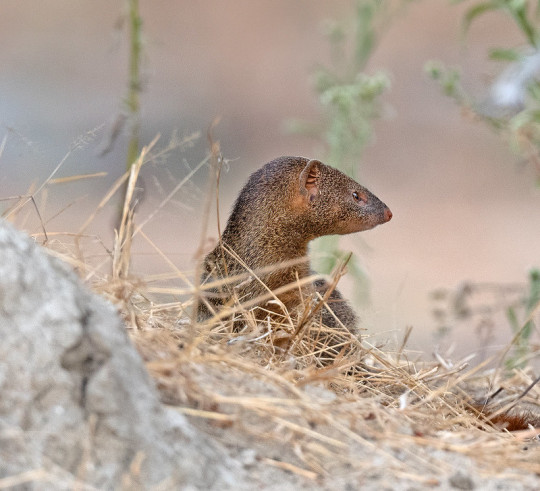
Common slender mongoose (Herpestes sanguineus)
Mvuu Lodge, Liwonde National Park, Malawi
Photos [1, 2] © David Russell
59 notes
·
View notes
Text
okokok i wanna make a list of interesting animals that i like and some of which i have trouble remembering sometimes. i will edit this over time. ok. i thought we would be able to do readmores on mobile by now but apparently not. ok (i also always forget the word reconcile so that can be here too)
...
MARSUPIALS common brushtail possum, quoll, tasmanian devil, thylacine, cuscus (common spotted cuscus, sulawesi bear cuscus, silky cuscus), opossum (white-eared opossum, four-eyed opossum, yapok/water opossum), tree kangaroo, glider (greater glider, yellow-bellied glider)
RODENTS rat, mouse, nutria, Gambian pouched rat, capybara, Brazilian porcupine, jerboa (long-eared jerboa), chinchilla, vizcacha
MUSTELIDS ferret, weasel, stoat, marten (yellow-throated marten), skunk (spotted skunk), mink, greater hog badger
PRIMATES tarsier, aye aye, ring tailed lemur, japanese macaque, gelada, marmoset (pygmy marmoset), capuchin, spider monkey (red-faced spider monkey), howler monkey, white-faced saki
VIVERRIDS binturong, civet (owston's palm civet, African civet, banded palm civet), linsang, genet
PROCYONIDS kinkajou, coati, ringtail/cacomistle, raccoon
HOGS wild boar (really been enjoying these lately) , red river hog, pygmy hog

FELINES margay, rusty-spotted cat, black-footed cat, asiatic golden cat, bornean bay cat, little spotted cat/oncilla, jaguarundi, sandcat, lynx, bobcat, caracal, serval, fishing cat, pallas' cat
ANTEATERS tamandua, giant anteater, silky anteater, pangolin
LAPINES rabbit (flemish giant rabbit, sumatran striped rabbit, Netherland dwarf broken chocolate colour (someone said i would be this if i was a bunny)), hare
OTHER MAMMALS fossa, mongoose (yellow mongoose, common slender mongoose), elephant shrew (black and rufous elephant shrew), treeshrew, colugo, spotted hyena, antelope (oryx, roan antelope), honduran white bat
FISH eel (New Zealand longfin eel, moray eel, gulper eel), black ghost knife fish
ARACHNIDS jumping spider, house spider, daddy long legs, huntsman spider, tarantula, camel spider, tailless whip scorpion, horseshoe crab
OTHER INVERTEBRATES snail (giant African snail), slug, slater/pill bug, isopod, praying mantis, bee (honeybee, bumble bee), moth, millipede, centipede, earwig, beetle, sand hopper
...
ok now im tired and im going to go to bed. i will readmore this tomorrow when im on the computer maybe. goodnight
5 notes
·
View notes
Text
OVERVIEW OF THE SAFARI TARANGIRE NGORONGORO FOR TWO DAYS
OVERVIEW OF THE SAFARI TARANGIRE NGORONGORO FOR TWO DAYS This two-day safari will take you to Tarangire National Park and the incredible Ngorongoro Crater, where you'll have time to explore wildlife and interact with animals such as elephants, lions, giraffes, antelopes, and more. Visiting the crater will bring back memories because there are so many animals to see.
ABOUT TARANGIRE: The national park of Tarangire is well-known for having a large population of elephants and baobab trees. Visitors to the park can view sizable herds of zebras, wildebeest, and Cape buffalo during the dry season, which lasts from June to November. Other typical inhabitants include giraffes, dik diks, sea antelopes, Grant's antelopes, vervet monkeys, banded mongoose, and olive baboons. Predators in the Tarangire include lions, leopards, jaguars, caracals, badgers, and wild dogs. The oldest elephant to give birth to twins is in Tarangire. An excellent illustration of how the birth of two healthy, thriving twin elephants may overcome all obstacles is the recent birth of elephant twins in Tanzania's Tarangire National Park. 550 different species of birds live there. 2 days ngorongoro
A birder's paradise, the park. Another well-known feature of the area are the numerous termite mounds. Wildlife study mostly focuses on Masai giraffes and African woodland elephants. The protected area has been recognized as a Lion Conservation Unit since 2005.
June and October are the best months to visit Tarangire. Animals move from nearby locations into the park. When they are close to a river, wild animals are easier to see. nice and sunny conditions The risk of malaria is decreased and there are fewer mosquitoes. From June through August, warm clothing is necessary due to the chilly morning matches. OCTOBER AND MAY The vegetation is gorgeous and lush. Due of the low season, prices are low. Because migratory birds are here now, it's the greatest time to go bird watching. Since many animals leave the park during migration, the dry season is the best time to see wildlife. The height of the rainy season occurs from March through May. 2 days ngorongoro
NGORONGORO'S HISTORY One of the top locations in Africa to watch wildlife is the Ngorongoro Conservation Area. Additionally, it is among the top tourist destinations in Tanzania. The primary activities in Ngorongoro Conservation Area include crater rim hikes to view wildlife (which can take up to 6 hours), visiting nearby Maasai settlements, and playing the game of driving around and in the crater. He is who he is. One can also go to the Hadzabe tribe and see Lake Magadi, Lerai Fever Forest, Olduvai Gorge, shifting sand, Mount Gol, Olmoti Crater, Empakaai Crater, Ol Karien Gorge, Nasera Rock, Salei Plain, Oldeani Mountain, Lake Natron, and Ol Doinyo Lengai. A shallow lake with alkaline water, Lake Magadi is well-liked by flamingos.
Other birds including flamingos appreciate the lake's seclusion, salt water, and profusion of algae. Hyenas and jackals are two other creatures that frequent the lake to add salt to their diet. One uncommon, slender, pale yellow acacia tree makes up the Lerai fever forest. These trees are loved by animals like rhinos, bush antelopes, elephants, elands, hyraxes, and birds. Ash from Mount Ol Dionyo is what causes quicksand.
Visitors to the area will enjoy the stunning sight of this ash slowly moving across the broad plains. In addition to Ngorongoro, other significant craters in the region include Olmoti and Empakaai. These two craters are great for taking nature hikes, seeing wildlife, and seeing Maasai herders take care of their animals. It proceeds along Thousands of zebras and wildebeest use this area as a main migration path as they go to and from the Serengeti grasslands. An old shelter was found by the Leakey family during one of their digs in the Ol Doinyo Lengai Mountains, which are close to the Kenyan border. Daring climbers flock to these isolated mountains, which are still active, to view the main crater filled with lava. travel to Maasai land Visit the villages of the Hadzabe tribe near Lake Eyasi for an amazing cultural trip in Tanzania. These bushmen still rely on hunting and gathering for their survival. Whistles and clicks make up the majority of their language. Near by Datoga and the Mbulu, who depend on farming and pastoralism for a living, dwell the Hadzabe. You might love our Serengeti and Ngorongoro Safari 3-Day Package if you're soon planning a vacation to the Ngorongoro Crater. We also provide a wonderful 6-day gorilla tour and a safari package that includes the Ngorongoro and Serengeti.
TIME TO VISIT NGORONGORO AT ITS BEST The greatest time to visit Ngorongoro Crater is in JANUARY since that is when the wildebeests are laying their eggs. The newborn animals struggling to stand up have fantastic photo chances because the herds are "mass spawning" on the lush plains just outside the crater. Between the two rainy seasons in the area, January and February might generate a dry season between "short rains" and "long rains.
February is one of the driest months at the crater before the rainy season begins in late March. It's a great time to view the wildlife, especially lion and hyena predators getting ready to hunt dense herds. In order to avoid crowds and enjoy a fair price, March is recognized as one of the finest months to visit Ngorongoro Crater. The crater is transformed into an emerald wonderland by the "long rains," which start in late March and last through April and May
The Ngorongoro Conservation Area is best visited in the month of June. There are fewer people on game drives now that the "long rains" have stopped. Peak season for the Ngorongoro Crater Expedition doesn't start until late June or early July. The colder weather this month makes it the perfect time to climb Mount Kilimanjaro, a well-liked addition. for the hunting expedition to Ngorongoro Crater
The months of JULY and AUGUST are the busiest for visitors to Ngorongoro Crater, and lodging in the area is typically very empty during these times. During the dry season, the visibility of wildlife along the arid plains and their frequent excursions to waterholes draw tourists from all over the world. Leopards, lions, rhinos, buffaloes, and other animals are frequently seen at this time of year.
Although SEPTEMBER is the beginning of spring, it still falls in the Ngorongoro Conservation Area's typical dry season. It can get chilly in Crater at this time of year. The crater's bottom has become a dusty bowl due to the recent dry weather, and the grasslands have gone yellow. October is a transitional month for the weather at Ngorongoro Crater, with the long dry season's peak occurring at the beginning of the month and the "brief rains" starting shortly before November.
3 notes
·
View notes
Note
thylacine but give it ✨bigger teeth ✨@megatronismegagone
....that really is the "needs more teef" version of a mongoose isnt it. same patterns
compare

[id: a thylacine, a canine-looking slender animal with stripes along its hindquarters. It has light paws and a somewhat darker face. The photo is black and white, but thylacines were tan. end id]
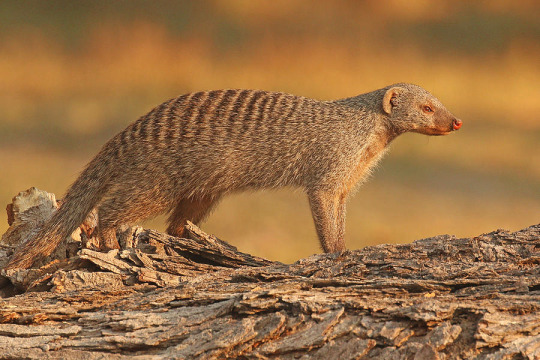
[id: a banded mongoose, similar in coloration and pattern to the thylacine above. The mongoose's fur is ticked where the thylacine's fur is unclear about whether or not it's visibly ticked, and the paws and face are darker than the body. The body is more otterlike than canine. end id]
anyway vibes, but im only giving it another 8/10 because Needs More Long and also if i'm gonna be a dark-backed canine-looking creature i might as well just be a black-backed jackal
6 notes
·
View notes